Last Monday, 79 year-old Egyptian President Hosni Mubarak announced his readiness to begin a national nuclear program, but carefully emphasizing it would invoke the United Nations’ International Atomic Energy Agency watchdog and “international partners”, when describing his plans for “several” nuclear power stations.
“We believe that energy security is a major part of building the future for this country and an integral part of Egypt’s national security system,” said Mubarak, adding that the civil program would work “within a framework of transparency and respect of commitments to the nuclear non-proliferation system.”
Strangely, Israeli media was noticeably quiet next day and the following, even after Mubarak announced his plan to build nuclear power plants – a proposal heralded in the Egyptian press as a major national project. Nor was there any comment from official sources in Jerusalem. Analysts believe that a new pattern is shaping in Sunni Arab nations, expressing growing interest in so-called nuclear programs, allegedly for “peaceful requirements” due to the spiraling oil prices, but the main focus seems to be Shi’ite Iran’s determined nuclear weapons ambition, which is already haunting Sunni Arab nations in the Middle East and not only in this region itself.
 President Mubarak’s announcement just one week before his National Democratic Party’s conference is regarded as no surprising coincidence. Used as a means to bolster the president’s flagging popularity, since the Moslem Brotherhood managed to strengthen its power in Parliament (thanks to President George W Bush’s catastrophic “democratization” policy), Mubarak needs everything in the book to strengthen his image in the eyes of his public. There can be no better way to achieve this by a dramatic declaration on such a highly prestigious national project. That this issue is very much ‘en vogue’ these days in Cairo seems to stem from Mubarak’s son Gamal’s call last September revealing plans for an Egyptian nuclear program – a call that reversed a policy by shelving such plans as a result of the 1986 Chernobyl accident. Incidentally, Gamal Mubarak’s 2006 speech also took place around the time of the party’s convention.
President Mubarak’s announcement just one week before his National Democratic Party’s conference is regarded as no surprising coincidence. Used as a means to bolster the president’s flagging popularity, since the Moslem Brotherhood managed to strengthen its power in Parliament (thanks to President George W Bush’s catastrophic “democratization” policy), Mubarak needs everything in the book to strengthen his image in the eyes of his public. There can be no better way to achieve this by a dramatic declaration on such a highly prestigious national project. That this issue is very much ‘en vogue’ these days in Cairo seems to stem from Mubarak’s son Gamal’s call last September revealing plans for an Egyptian nuclear program – a call that reversed a policy by shelving such plans as a result of the 1986 Chernobyl accident. Incidentally, Gamal Mubarak’s 2006 speech also took place around the time of the party’s convention.
While Israel should of course be carefully monitoring these developments, but publicly is saying nothing, a nagging thought must be bothering the Israeli intelligence community, what could happen to Egypt’s new nuclear technology if, for instance, Islamic radicals took power or, if the 1969 Peace Agreement should then be cancelled under much different strategic circumstances? Being an issue of real concern, but certainly not one which is being discussed publicly by Israeli decision-makers it remains, this certainly remains a big question mark!

Egypt’s Budding Nuclear Program – a Continuing Dilemma
In March 2004, US and British intelligence officials reported on evidence found that Libya traded nuclear and missile expertise with Egypt. It appeared that Egypt could been using Libya as a way-station for obtaining nuclear and missile technology and components from North Korea. Earlier, in 2002, Egypt denied US allegations that Cairo was conducting secret missile and WMD trade with Libya. The allegations were based on CIA satellite photographs.
In January 2005, the head of Mossad, Meir Dagan, warned the Knesset Foreign Affairs and Defense Committee, that there were indications on several Middle East states other than Iran – including Egypt and Syria – working at varying stages in development of indigenous nuclear programs.
Days after, former Mossad chief Ephraim Halevy expressed fears that Syria, Egypt and Saudi Arabia might have acquired some kind of nuclear capability via an illicit weapons trafficking network run by Dr Abdul Qadeer Khan, the chief architect of Pakistan’s nuclear bomb. Israeli military sources recently told The Jerusalem Post that, thanks to Khan, one of those three Arab states now has the potential to achieve a “significant nuclear leap.”
Since the early Eighties, Egypt is the annual recipient of about $2 billion in aid from the U.S. foreign assistance program, and this year the Bush administration has agreed to increase the amount to $2.3 billion. The United States had expressed concern about reports that Egypt has a secret uranium research program and said it supports further investigation by the International Atomic Energy Agency (IAEA). Indeed, the UN nuclear agency also claimed in its recent report, that Egypt might have conducted secret nuclear experiments in violation of international non-proliferation treaties.
Egypt previously had obtained technology directly from Pyongyang, intelligence officials said, but the U.S. blocked a shipment of missiles in 2001. Nevertheless, the House subcommittee on terrorism learned a year later Egypt received 24 No-Dong missile engines from North Korea. These reports emerged following the dramatic changes in Libya’s strategy, when Muammar Qaddafi allowed western experts to visit his secret weapons locations. When experts from the United States and the International Atomic Energy Agency (IAEA) came upon blueprints for a 10-kiloton atomic bomb in the files of the Libyan weapons program earlier this year, they also discovered some disturbing documents, pertaining to sofar suspected, but not proven intelligence rumors. The documents also confirmed U.S. suspicions of secret trade between Cairo and Tripoli in strategic weapons obtained from North Korea.
On the evidence found the experts gained new appreciation on the audacity of the rogue nuclear network led by the notorious Pakistani nuclear scientist Dr Abdul Qadeer Khan. Intelligence officials had watched Dr. Khan for years and suspected that he was trafficking in machinery for enriching uranium to make fuel for warheads. But the detailed design represented a new level of danger, particularly since the Libyans disclosed that he sold them $100 million worth of nuclear gear. Among documents seized in Libya, Investigators learned, that Dr Khan had traveled extensively throughout the Middle East and among others, secretly visited Syria, Saudi Arabia and Egypt, on what they believed were business trips, either to buy materials like uranium ore or even sell atomic goods.
American intelligence officials had Dr. Khan under surveillance for nearly three decades, since he began assembling components for Pakistan’s bomb, but apparently missed some of his crucial transactions and secret negotiations in the Middle East.
The Libyan findings further cooled the already straining relations between Washington and the United Nations atomic agency and its director general, Mohamed El-Baradei, whom they are trying to replace this year.
Ever since Egypt first came to perceive Israel as having launched a nuclear program, and later (some time in the early 1970s) as having most likely crossed the nuclear threshold, Egypt has been struggling to come to terms with the regional implications of this development.
Dominating Egypt’s efforts over the past decades is its pursuit of an intense and ongoing diplomatic process to bring Israel to sign the Non Proliferation Treaty (NPT) and place its nuclear facilities under the IAEA safeguard regime. Egypt’s own nuclear program is a delicate balance of championing nuclear nonproliferation in the Middle East, developing civilian nuclear industry to address its economic and electricity needs, while at the same time seeking some guarantee of security against the Israeli nuclear threat.
 At the center of Egypt’s nuclear program is the Inshas Nuclear Research Center in Cairo. Inshas hosts a 2-megawatt, Soviet-supplied research reactor that started in 1961 and runs on ten-percent-enriched uranium fuel. The reactor was shut down for renovation during the 1980s, but started up again in 1990. In 1992, Egypt had signed a contract with Invap, Argentina’s leading nuclear organization, to build a 22-megawatt research reactor at Inshas. According to statements by an official at Argentina’s embassy in Washington, DC, construction began in March 1993.
At the center of Egypt’s nuclear program is the Inshas Nuclear Research Center in Cairo. Inshas hosts a 2-megawatt, Soviet-supplied research reactor that started in 1961 and runs on ten-percent-enriched uranium fuel. The reactor was shut down for renovation during the 1980s, but started up again in 1990. In 1992, Egypt had signed a contract with Invap, Argentina’s leading nuclear organization, to build a 22-megawatt research reactor at Inshas. According to statements by an official at Argentina’s embassy in Washington, DC, construction began in March 1993.
Egypt’s Nuclear Materials Authority has directed uranium exploration to concentrate on four areas in the eastern desert: Gabal Gattar, El Missikat, El Erediya and Um Ara. A new uranium-bearing area, Gabal Kadabora, has been discovered in the central eastern desert and is now under evaluation. Egypt has not in the past and does not presently appear to be aggressively pursuing nuclear weapons, however a recent increase in calls by military officers, government officials, and scholars to develop an Arab deterrent to Israel signals a growing frustration with what it perceives to be the international community’s double standard regarding nuclear proliferation in the region.
Statements made by high-level Egyptian officials and various media reports overwhelmingly target Israel as Egypt’s major concern in the nuclear realm. Embedded in these latest statements, however, are clear hints of Egypt’s broader regional considerations, which make its agenda on nuclear issues more varied and complex. Egypt is particularly concerned how nuclear development and potential proliferators in the Middle East impact on its own regional prominence.
Looking at what has happened more recently with India and Pakistan since they became declared nuclear states, Egypt could conclude that the implications of going nuclear might not be that serious, especially in light of American-Pakistani cooperation since September 11. In this context, Egypt will most likely be very interested in U.S. policy toward North Korea and dealing with Iran’s nuclear ambitions.
The Egyptian leadership has not closed the door on the atomic option altogether. The most prominent of these came from President Hosni Mubarak. In an interview with the London Arabic-language daily Al-Hayat in early October 1998, Mubarak said: “We do not think now of entering the nuclear club because we do not want war… We are not in a hurry. We have a nuclear reactor at Inshas, and we have very capable experts. If the time comes when we need nuclear weapons, we will not hesitate”.
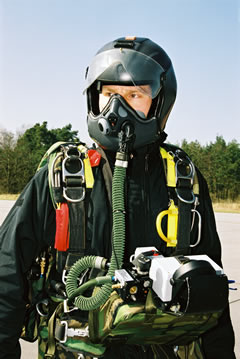 “A paratrooper using ParaFinder “is essentially equipped with all necessary flying instruments,” observes Jens Gönnemann, head of systems development and testing at EADS Defence & Security Systems. The first country to acquire this system, Germany, decided in the fall of 2003 to equip its special forces with it. ParaFinder and ParaLander. Using satellite based GPS navigation and automatic guidance and control, these autonomous precision aerial delivery systems could covertly guide men and materials precisely to predefined landing zone keeping the transport aircraft remote from this area, operating outside the reach of the enemy’s air defenses. The paratroopers and their loads are silent, have a small radar reflection and are virtually impossible to detect, especially at night. Utilizing the new navigation systems, insertion can be performed under all weather conditions, assuring soft, risk-free landing.
“A paratrooper using ParaFinder “is essentially equipped with all necessary flying instruments,” observes Jens Gönnemann, head of systems development and testing at EADS Defence & Security Systems. The first country to acquire this system, Germany, decided in the fall of 2003 to equip its special forces with it. ParaFinder and ParaLander. Using satellite based GPS navigation and automatic guidance and control, these autonomous precision aerial delivery systems could covertly guide men and materials precisely to predefined landing zone keeping the transport aircraft remote from this area, operating outside the reach of the enemy’s air defenses. The paratroopers and their loads are silent, have a small radar reflection and are virtually impossible to detect, especially at night. Utilizing the new navigation systems, insertion can be performed under all weather conditions, assuring soft, risk-free landing.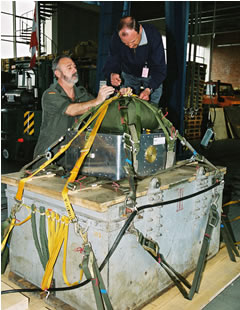

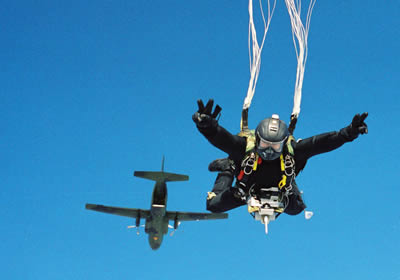

 Sofar, world attention has focused on Iran’s uranium enrichment program. This process is far from being simplistic affair. Basic uranium enrichment involves increasing the concentration of fissile U-235 found in uranium, which must be enriched to about 3.5 percent for a controlled nuclear reaction, however weapons-grade uranium requires enrichment to over 90%. The entire process requires passing uranium through a series of centrifuges, which are 1.8cm-high spinning tubes creating centrifugal force separating the different uranium isotopes. By connecting 164 of the centrifuge machines together in a cascade, the gas is successively enriched in several individual stages, providing the basic module for an enrichment facility.
Sofar, world attention has focused on Iran’s uranium enrichment program. This process is far from being simplistic affair. Basic uranium enrichment involves increasing the concentration of fissile U-235 found in uranium, which must be enriched to about 3.5 percent for a controlled nuclear reaction, however weapons-grade uranium requires enrichment to over 90%. The entire process requires passing uranium through a series of centrifuges, which are 1.8cm-high spinning tubes creating centrifugal force separating the different uranium isotopes. By connecting 164 of the centrifuge machines together in a cascade, the gas is successively enriched in several individual stages, providing the basic module for an enrichment facility.
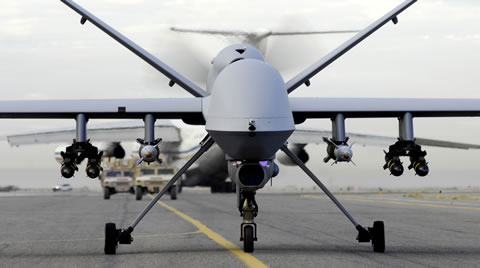
 Unlike the USAF Reapers, used as ‘hunter killer’ platforms, loaded with guided bombs and Hellfire missiles, the RAF Reaper UAVs are currently unarmed but the RAF is planning to fly armed missions as soon as by 2007 year’s end.
Unlike the USAF Reapers, used as ‘hunter killer’ platforms, loaded with guided bombs and Hellfire missiles, the RAF Reaper UAVs are currently unarmed but the RAF is planning to fly armed missions as soon as by 2007 year’s end. The USAF Reaper are operational in Afghanistan since September 2007 averaging about one sortie per day. As practiced with Predator As, Reapers are operated by the
The USAF Reaper are operational in Afghanistan since September 2007 averaging about one sortie per day. As practiced with Predator As, Reapers are operated by the  The RAF’s participation in the joint US/UK Combined Predator Task Force gave them a unique insight into the USAF (US Air Force) Predator A operations, which allowed a seamless transition to the RAF’s use of Reaper, the UK variant of Predator B.
The RAF’s participation in the joint US/UK Combined Predator Task Force gave them a unique insight into the USAF (US Air Force) Predator A operations, which allowed a seamless transition to the RAF’s use of Reaper, the UK variant of Predator B.


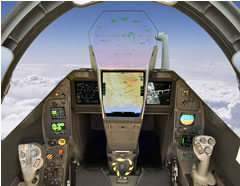

 President Mubarak’s announcement just one week before his National Democratic Party’s conference is regarded as no surprising coincidence. Used as a means to bolster the president’s flagging popularity, since the Moslem Brotherhood managed to strengthen its power in Parliament (thanks to President George W Bush’s catastrophic “democratization” policy), Mubarak needs everything in the book to strengthen his image in the eyes of his public. There can be no better way to achieve this by a dramatic declaration on such a highly prestigious national project. That this issue is very much ‘en vogue’ these days in Cairo seems to stem from Mubarak’s son Gamal’s call last September revealing plans for an Egyptian nuclear program – a call that reversed a policy by shelving such plans as a result of the 1986 Chernobyl accident. Incidentally, Gamal Mubarak’s 2006 speech also took place around the time of the party’s convention.
President Mubarak’s announcement just one week before his National Democratic Party’s conference is regarded as no surprising coincidence. Used as a means to bolster the president’s flagging popularity, since the Moslem Brotherhood managed to strengthen its power in Parliament (thanks to President George W Bush’s catastrophic “democratization” policy), Mubarak needs everything in the book to strengthen his image in the eyes of his public. There can be no better way to achieve this by a dramatic declaration on such a highly prestigious national project. That this issue is very much ‘en vogue’ these days in Cairo seems to stem from Mubarak’s son Gamal’s call last September revealing plans for an Egyptian nuclear program – a call that reversed a policy by shelving such plans as a result of the 1986 Chernobyl accident. Incidentally, Gamal Mubarak’s 2006 speech also took place around the time of the party’s convention.
 At the center of Egypt’s nuclear program is the Inshas Nuclear Research Center in Cairo. Inshas hosts a 2-megawatt, Soviet-supplied research reactor that started in 1961 and runs on ten-percent-enriched uranium fuel. The reactor was shut down for renovation during the 1980s, but started up again in 1990. In 1992, Egypt had signed a contract with Invap, Argentina’s leading nuclear organization, to build a 22-megawatt research reactor at Inshas. According to statements by an official at Argentina’s embassy in Washington, DC, construction began in March 1993.
At the center of Egypt’s nuclear program is the Inshas Nuclear Research Center in Cairo. Inshas hosts a 2-megawatt, Soviet-supplied research reactor that started in 1961 and runs on ten-percent-enriched uranium fuel. The reactor was shut down for renovation during the 1980s, but started up again in 1990. In 1992, Egypt had signed a contract with Invap, Argentina’s leading nuclear organization, to build a 22-megawatt research reactor at Inshas. According to statements by an official at Argentina’s embassy in Washington, DC, construction began in March 1993.



 GDLS and AM General invested over $10 million for risk reduction development and maturation of this vehicle and its innovative In-Hub Hybrid Electric Drive system. AGMV has unique protection attributes, combining a hexagon shaped armored capsule for mine protection while optimizing also for side blast deflection and small-arms protection. At a gross vehicle weight of 14,000 – 16,000 lbs with integral A kit armor, protecting against small arms, mines, IEDs and blast, the new vehicle can carry payloads of up to 5,000 lbs and be air transportable in C-130, CH-53 and CH-47.
GDLS and AM General invested over $10 million for risk reduction development and maturation of this vehicle and its innovative In-Hub Hybrid Electric Drive system. AGMV has unique protection attributes, combining a hexagon shaped armored capsule for mine protection while optimizing also for side blast deflection and small-arms protection. At a gross vehicle weight of 14,000 – 16,000 lbs with integral A kit armor, protecting against small arms, mines, IEDs and blast, the new vehicle can carry payloads of up to 5,000 lbs and be air transportable in C-130, CH-53 and CH-47.
 Light Utility Hybrid (LUV) from MillenWorks
Light Utility Hybrid (LUV) from MillenWorks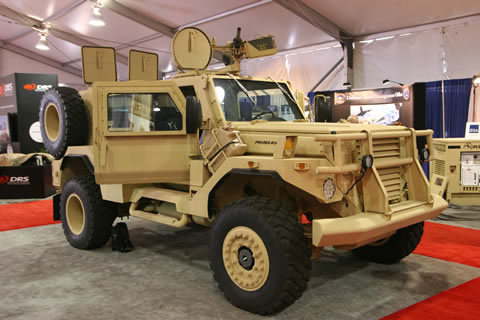
 Protected Vehicles Inc. introduced at Modern Day Marine 2007 the
Protected Vehicles Inc. introduced at Modern Day Marine 2007 the  The vehicle is offered in both, hardtop (fully protected) and soft top configurations. The hardtop version carries a payload of 7,000 – 9,500 lbs while the soft top can carry up to 12,000 lbs of payloads. Despite its low weight, Protector provides full protection from mines, IEDs and small arms. It is fitted with basic armor (A kit) protecting against small arms for the body and windows. Protector carries a weapon mount for 0.50 or M240/249 machine guns and provides rifle ports on all sides. The vehicle can be fitted with Hutchinson runflat tires and is protected from mine explosions, both under the wheels and centerline. Protection level can be enhanced to meet specific requirements. For example, a B kit protecting up to 0.50 Cal weighs about 1,100 lbs, and full IED, FSP and EFP protection would weigh up to 5,000 lbs.
The vehicle is offered in both, hardtop (fully protected) and soft top configurations. The hardtop version carries a payload of 7,000 – 9,500 lbs while the soft top can carry up to 12,000 lbs of payloads. Despite its low weight, Protector provides full protection from mines, IEDs and small arms. It is fitted with basic armor (A kit) protecting against small arms for the body and windows. Protector carries a weapon mount for 0.50 or M240/249 machine guns and provides rifle ports on all sides. The vehicle can be fitted with Hutchinson runflat tires and is protected from mine explosions, both under the wheels and centerline. Protection level can be enhanced to meet specific requirements. For example, a B kit protecting up to 0.50 Cal weighs about 1,100 lbs, and full IED, FSP and EFP protection would weigh up to 5,000 lbs.
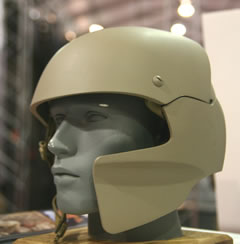
 Protected Head Gear
Protected Head Gear Advanced Combat Helmet that will offer increased performance by adding face, neck and increased head protection. The new helmet uses a split-shell design featuring an air vent across the top, for heat stress reduction. It also employs a novel suspension, designed for improved stability, reducing weight adding comfort and impact protection. Interchangeable face armor components will make this future helmet adaptable to increasing threat levels. Among the latest protection device, one of the products bringing relief to many warfighters is the new ballistic groin protector from ArmorWorks, based on a similar, non-ballistic groin protector cup widely used by baseball players. The new ballistic cup is made from Kevlar is designed to protect warfighter’s sensitive body organs against fragments, small arms fire and impact. The product is anatomically shaped for the male and female groin area and its design ensures comfort over extended use.
Advanced Combat Helmet that will offer increased performance by adding face, neck and increased head protection. The new helmet uses a split-shell design featuring an air vent across the top, for heat stress reduction. It also employs a novel suspension, designed for improved stability, reducing weight adding comfort and impact protection. Interchangeable face armor components will make this future helmet adaptable to increasing threat levels. Among the latest protection device, one of the products bringing relief to many warfighters is the new ballistic groin protector from ArmorWorks, based on a similar, non-ballistic groin protector cup widely used by baseball players. The new ballistic cup is made from Kevlar is designed to protect warfighter’s sensitive body organs against fragments, small arms fire and impact. The product is anatomically shaped for the male and female groin area and its design ensures comfort over extended use.
 Magpul Introduces the Masada Adaptive Combat Weapon
Magpul Introduces the Masada Adaptive Combat Weapon
 Over a thousand CREW systems of an earlier version are currently operating in theater. These systems were delivered last year by EFW, as part of a rapid fielding effort made by JIEDDO. At MDM 07 and AUSA 07 the company displayed the latest upgraded version of the system, offering more sophisticated programming and power management enabling efficient operation of collocated communications systems. The new system utilizes the same antenna payload and mast of current CREW systems.
Over a thousand CREW systems of an earlier version are currently operating in theater. These systems were delivered last year by EFW, as part of a rapid fielding effort made by JIEDDO. At MDM 07 and AUSA 07 the company displayed the latest upgraded version of the system, offering more sophisticated programming and power management enabling efficient operation of collocated communications systems. The new system utilizes the same antenna payload and mast of current CREW systems. Countermeasures are only one facet of combating IEDs. An RG-33 MRAP displayed at MDM 07 demonstrated another step forward in the defeat of IEDs, based on the location, identification and disruption or initiation of the suspected object from a safe distance.
Countermeasures are only one facet of combating IEDs. An RG-33 MRAP displayed at MDM 07 demonstrated another step forward in the defeat of IEDs, based on the location, identification and disruption or initiation of the suspected object from a safe distance. Among the aviation programs promoted at the 2007 Modern Day Marine expo were the new CH-53K Sikorsky, and FireScout Vertical Takeoff and Landing Unmanned Aerial Vehicle (VT-UAV) from Northrop Grumman, which was presented for the first time as a weaponized platform, loaded with a quad launcher carrying Viper Strike weapons. Models of Sikorsky’s future helicopter versions based on the X2 coaxial rotor propulsion system included a VT-UAV, an attack helicopter which could become a future successor for the AH-1W Cobra and an assault helicopter platform, a potential successor to the UH-60 helicopter.
Among the aviation programs promoted at the 2007 Modern Day Marine expo were the new CH-53K Sikorsky, and FireScout Vertical Takeoff and Landing Unmanned Aerial Vehicle (VT-UAV) from Northrop Grumman, which was presented for the first time as a weaponized platform, loaded with a quad launcher carrying Viper Strike weapons. Models of Sikorsky’s future helicopter versions based on the X2 coaxial rotor propulsion system included a VT-UAV, an attack helicopter which could become a future successor for the AH-1W Cobra and an assault helicopter platform, a potential successor to the UH-60 helicopter. 
 A new concept from Boeing highlighted a future pulsejet powered hevy lift VTOL platform, capable of carrying medium armored vehicles weighing up to 30 tons. Advanced PulseJet Vertical Lifters Boeing is studying a vertical take-off and landing (VTOL) aircraft that could lift heavy payloads of up to 30 tons, utilizing innovative ‘advanced pulsejet’ propulsion. While basic pulsejet is well understood (it was implemented in the 1940s with the V-1 flying bombs) Boeing
A new concept from Boeing highlighted a future pulsejet powered hevy lift VTOL platform, capable of carrying medium armored vehicles weighing up to 30 tons. Advanced PulseJet Vertical Lifters Boeing is studying a vertical take-off and landing (VTOL) aircraft that could lift heavy payloads of up to 30 tons, utilizing innovative ‘advanced pulsejet’ propulsion. While basic pulsejet is well understood (it was implemented in the 1940s with the V-1 flying bombs) Boeing  X2 VT-UAV
X2 VT-UAV Boomerang III Acoustic Gunshot detector
Boomerang III Acoustic Gunshot detector MPSVS from EDO
MPSVS from EDO ODR HV from ODF Optronics
ODR HV from ODF Optronics

 VIPeR from Elbit Systems
VIPeR from Elbit Systems For example, the small RMP 50 weighs only 70 lbs (32 kg), but has a maximum payload capacity of 75 lb (34 kg). The RMP 400 has even better ratio – at a curb weight of 240 lbs (109kg) it can carry 400 lbs of payload (181 kg). These robots are designed to operate at a range of 10 – 15 miles (16-24 km) at an off-road speed of up to 18 mph (29 km/h). The RMP robot is powered by 48 NiMh batteries while the larger models use multiple Saphion lithium-ion battery packs. Both versions require battery recharging for 8 – 10 hours. Although these are well adapted to harsh field conditions, the batteries temperature tolerance limit their operational use from -10 to +50 C. This range could be expanded by using different batteries, which could be more suitable for sub-freezing conditions. (Some Saphion cells operate as low as -20C).
For example, the small RMP 50 weighs only 70 lbs (32 kg), but has a maximum payload capacity of 75 lb (34 kg). The RMP 400 has even better ratio – at a curb weight of 240 lbs (109kg) it can carry 400 lbs of payload (181 kg). These robots are designed to operate at a range of 10 – 15 miles (16-24 km) at an off-road speed of up to 18 mph (29 km/h). The RMP robot is powered by 48 NiMh batteries while the larger models use multiple Saphion lithium-ion battery packs. Both versions require battery recharging for 8 – 10 hours. Although these are well adapted to harsh field conditions, the batteries temperature tolerance limit their operational use from -10 to +50 C. This range could be expanded by using different batteries, which could be more suitable for sub-freezing conditions. (Some Saphion cells operate as low as -20C).











